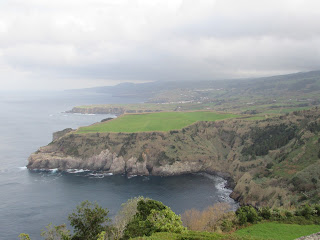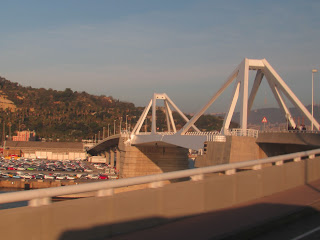The Azores is a cluster of 9 Portuguese islands in the middle of the Atlantic Ocean about 800 miles off the coast of Portugal.
We have been to the Azores twice before and did tours of the island both times. Our friend, Gay, once again found a tour that looked very interesting to us. She posted the information on our cruisecritic.com roll call forum and over several weeks more and more people contacted the tour company, Green Visions, and joined the tour. We had about 6 or 7 vans of 8 people each, all with our own driver. All the vans went their own way but everyone would meet up at a local farmhouse for a typical Portuguese lunch.
Our van had only 6 as one couple did not show. Our driver/guide was Eduardo Filipe Miranda; he is a photographer who also does tours. Green Visions hired him for the day to guide us around the island and he proved to be an excellent choice.
It was a cloudy, foggy day and we knew when we pulled into the port that it would be impossible to see any of the volcanic lakes high in the mountains.
So Eduardo revised the itinerary and it included stops that we had not done in our previous visits to the island.
One stop that was new was Our Lady of Peace church high atop a hill.
Each of the blue and white tiles depicted a Biblical scene.
We peeked inside the small chapel that dates back to 1764....
The hillside next to the steps is filled with hydrangea bushes. The island is filled with beautiful flowers, but not so much in November. These were well past their prime bloom.
Back in the van we headed back down out of the clouds and stopped at a little town for a few photos.
We stopped by island's Furnas Valley where we saw hot springs, geysers, and hot mud pools.
We also stopped at a tea factory that was different than the one we had stopped at on previous visits.
The property was very beautiful.
A nice young lady showed us the equipment used to process the tea leaves...
We stopped at a local farmhouse and experienced a home-cooked full Portuguese meal including appetizers of local cheese, sausage and fresh pineapple grown on the island. The main courses included a fish and a pork dish with local vegetables and salad and a Portuguese dessert.
The family had rearranged their dining and living rooms to make way for tables to accommodate about 55 people.
Eduardo sat with us and explained all the dishes as we were served.
Terry gave our hostess, the farm wife, a big hug and thank you. It was a very nice meal the family prepared for us.
It was then time to head back to the ship and begin our 6 days at sea before reaching Fort Lauderdale, Florida the day before Thanksgiving. The seas were fairly calm and we enjoyed our time during those last days of the cruise visiting with our new friends, expressing hopes that we will travel together again.
In fact we will be soon traveling again with Gay and Phil and Richard and Karen from this cruise and also Gwen and Jerry, who we met on our Baltic cruise in 2014. We all will be cruising the Galapagos islands later this spring on the yacht, M/V Evolution, through the company Quasar Expeditions....so stay tuned for another adventure of AngellTravels!























































































